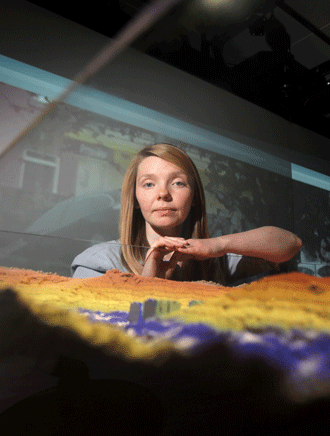July
New flood action team launched to investigate flash flooding across the UK

A band of ‘storm chasers’ has been set up by Newcastle University to help collect data about flash flooding and inform the way we manage future flood risk.
With their specially-adapted ‘storm mobile’, the team of scientists are using met-office weather data to track intense rainfall and head off to areas where flash flooding is most likely to occur.
Using GPS data and laser scans, together with social media, photographs and videos of the affected area, the team are able to provide crucial data needed to create hydraulic models to build up an accurate picture of the flooding and identify key causes and trigger points.
Ultimately, the aim is to further our understanding of when and where flash flooding is likely to occur and develop new systems to reduce the damage and impact on communities.
Dr Geoff Parkin, one of the ‘storm chasers’ and a senior lecturer at Newcastle University, explains: “Extreme rainfall events may only last for a few hours at most, but can generate terrifying and destructive floods.
“But the severity of the flood isn’t just dependent on the amount of rain that falls – there are many other contributing factors such as the shape of the catchment, the geology and land-use.
“The aim of the Flood Action Team is to collect as much data as possible during these extreme storms so we can build a more accurate picture and better predict where in the UK they are most likely to occur and how severe the outcomes might be.
“But this isn’t just about collecting data – this is also about finding solutions, mitigating the impact of flooding and helping communities to become more resilient to extreme weather.”
The Flood Action Team is led by Professors Andy Russell and Andy Large who are based in the School of Geography at Newcastle University.
Last weekend, researcher Dr Matt Perks was on the scene at Alyth and Bankfoot in Perthshire to collect data from the most recent flash flood to hit the UK.
“The more information we have, the more accurate our models will be,” explains Matt. “Because the floods tend to come and go very quickly we use everything from water-lines on walls and buildings, to videos of submerged vehicles and debris accumulations and damage to property – it’s a bit like being a detective and building a forensic picture of the events that led up to a crime scene.”
Dr Parkin, a Morpeth resident whose home was severely damaged by the 2008 floods leaving him out of his home for seven months, says the town is a good example of what can be achieved when communities and agencies work together.
Following a detailed study of the flooding by Newcastle University, the Environment Agency has now installed a number of flood defences in Morpeth and built a storage reservoir upstream to hold back excess water. They are also about to install log-catchers in the river that have been designed to trap large debris such as logs and branches which in 2008 blocked the river and caused even more severe flooding.
“For this project to be successful we need the public’s help to gather as much information as possible, particularly photographs, videos, and narrative evidence on what happened, so that we can reconstruct the events as accurately as possible, and therefore understand their causes.”
“Any information will be fed back to communities and used to drive forward improvements in how such events can be better predicted and prevented.”
Funded by the Natural Environment Research Council (NERC) through the Flooding From Intense Rainfall programme, the Flood Action Team are part of the SINATRA (susceptibility of catchments to intense rainfall and flooding) project which is led jointly by the universities of Newcastle and Reading. Led by Professor Hayley Fowler, the team use the Met Office forecasting charts to track the weather and anticipate where intense weather might hit the UK.
To get in touch with the Flood Action Team (FloAT) email float@newcastle.ac.uk
published on: 23 July 2015
